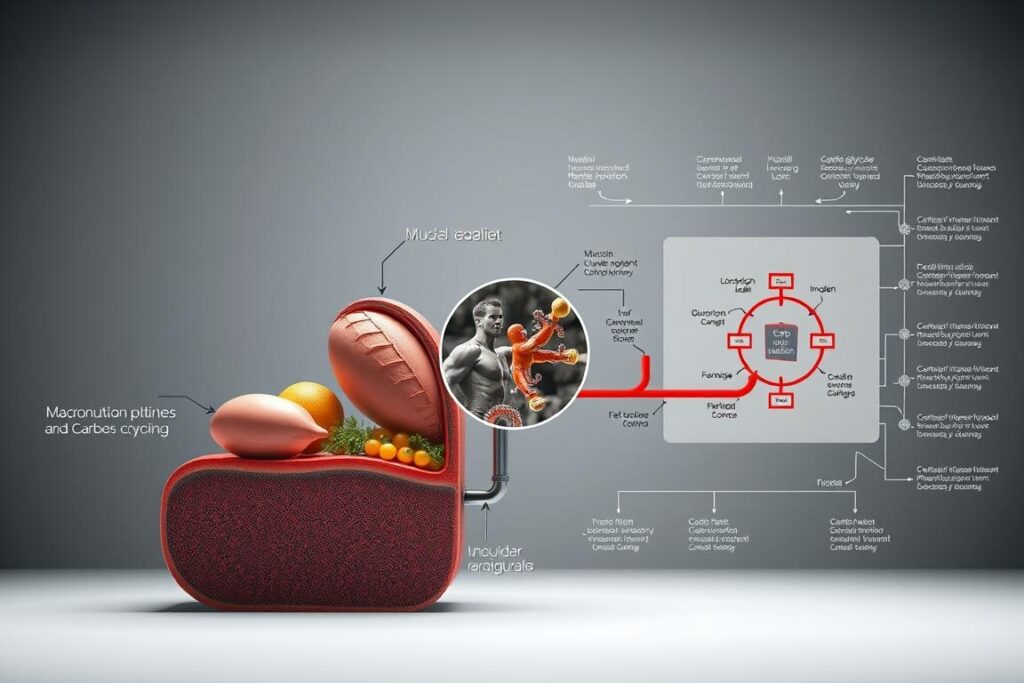
Intermittent Carb Cycling: Benefits for Muscle and Fat Loss
Intermittent carb cycling benefits can help you train hard while nudging the scale down and keeping muscle intact.
Picture a week where high-carb days refill your energy and make your lifts feel effortless, and lower-carb days help you manage calories without feeling drained.
How does it work? Match heavier training to higher carbohydrate intake so glycogen is full when you need it. On calmer days, reduce carbs and raise healthy fats while keeping protein steady.
This approach can improve performance on key sessions and support fat loss without a constant low-carb diet. Science shows short-term safety for healthy people, but long-term data are limited, so use it as a targeted tool.
Quick note: prioritize whole grains, legumes, fruits, starchy vegetables, and low-fat dairy, and consult a clinician if you have diabetes, are pregnant, underweight, or have a history of disordered eating.
Key Takeaways
- Use higher carbs on heavy training days and lower carbs on rest or low-intensity days.
- Keep protein steady to protect muscle while adjusting fats to balance calories.
- Choose quality carbohydrates to support energy and metabolic health.
- Short-term use is generally safe for healthy people; long-term effects need more study.
- Avoid this approach if you have diabetes or a history of disordered eating without professional guidance.
What carb cycling is and why lifters and athletes use it
What if your weekly eating plan matched how intense your workouts are each day?
In plain terms, carb cycling rotates how many carbs you eat across the week. You eat more on hard training days and less on easy or rest days. The goal is simple: refill muscle glycogen for key sessions and encourage fat use when demand is low.
How does that look week-to-week? Many athletes match high carbs to heavy lifts or intervals. Low-carb days pair with light exercise or rest. Protein stays steady to protect muscle. Fats drop on high-carb days and rise when carbs fall.
- High days: more energy for intense sessions.
- Low days: fewer calories, more fat burning.
- Flexible: adjust by weight and training load.
| Day type | Typical carbs |
|---|---|
| Hard training | 175–350 g |
| Easy training | 100–125 g |
| Very low / keto-style | <30 g |
Intermittent carb cycling benefits
Can timing your higher and lower carbohydrate days make your workouts stronger and your diet easier to follow?
Building and preserving muscle: glycogen, performance, and recovery
High-carb periods refill muscle glycogen so you can train harder and recover faster. That reduces muscle breakdown during intense lifts and helps you hold strength while dieting.
Accelerating fat loss through metabolic flexibility and calorie control
Lower-carb days cut total energy intake and encourage your body to burn more fat between hard sessions. Over time, this pattern may improve metabolic flexibility — the ability to switch between glucose and fat as fuel.
Hormones, glucose control, and overall metabolic health
Matching carbohydrate intake to demand can help steady glucose and may support insulin sensitivity, especially when you choose fiber-rich carbohydrates.
Strategic higher-carb refeeds may also help regulate hunger hormones like leptin and ghrelin so dieting feels more sustainable.
- Want stronger sessions without losing leanness? Use higher carbs on hard training days.
- Want better fat loss? Use lower-carb days to manage calories and encourage fat use.
- Remember: evidence is promising but not definitive — pair this with a clear calorie plan and consistent training.
| Focus | What it does | Practical tip |
|---|---|---|
| Muscle & performance | Refills glycogen, reduces breakdown | Eat more carbs on heavy lift days; keep protein steady |
| Fat loss & metabolism | Controls calories, encourages fat use | Lower carbs on rest days; increase healthy fats |
| Hormones & glucose | May improve insulin sensitivity and hunger signals | Prioritize fiber and whole carbohydrates; time refeeds around big sessions |
How carb cycling works under the hood
Visualize your body as a hybrid engine. On some days it runs on fast fuel. On others it leans on longer-lasting reserves. This simple idea explains how cycling carbs around training helps performance and weight control.

High‑carb days: refilling glycogen and fueling intensity
High days act like a “top-off.” You target roughly 175–350 g of carbs (about 2–2.5 g per pound) after tough sessions to refill glycogen. That gives quick fuel for heavy lifts and intervals.
Keep fat lower on these days so extra calories are used for performance, not storage. Keep protein steady to help repair and hold muscle.
Low‑carb days: tapping fat stores with higher dietary fats
On low days you cut carbs to around 100–125 g or lower in some plans. You raise healthy fats so meals stay satisfying while the body taps stored fat between workouts.
Fiber‑rich carbohydrates slow glucose spikes and help steady energy. Think of this plan as training your metabolism to switch fuel sources across the week.
| Day type | Typical carbs (g) | Main focus |
|---|---|---|
| High training day | 175–350 | Refill glycogen; fuel intense work |
| Moderate day | 100–125 | Maintain energy; moderate intake |
| Very low day | <30 | Maximize fat use; lower weight slowly |
Choose a cycling pattern that fits your week and goals
Choose a weekly pattern that fits your gym timetable and your life, not the other way around. Pick a plan that lines up with your hard sessions and your rest days. That keeps training quality high and makes the diet easier to follow.
Training‑matched plan
Pair higher carbs with hard lifts or intervals and lower carbs on easy or rest days. It’s simple and flexible.
- Pros: Better performance on big sessions, easier to recover.
- Cons: Needs weekly planning and meal timing around workouts.
5:2 style and refeed blocks
Try five lower‑carb days then two higher‑carb days for long cuts. Or add 1–3 consecutive refeed days every few weeks to break plateaus.
- Pros: Maintains a calorie deficit while protecting morale and glycogen.
- Cons: May require tighter tracking of calories on lower days.
Setting daily ranges by size and activity
Use body size and workload to set ranges. Common layouts:
- High training day: 175–350 g carbs.
- Low or easy day: 100–125 g carbs.
Start conservative. Track weight, training, and appetite. Then fine‑tune how many high versus low days you need.
| Plan | Typical day carbs (g) | Best for |
|---|---|---|
| Training‑matched | 175–350 (high) / 100–125 (low) | People who train hard several times weekly |
| 5:2 rhythm | Five lower days (100–125), two higher days (175–300) | Longer cuts needing structure and refeed timing |
| Refeed blocks | 1–3 higher days (200–350) every few weeks | Those hitting plateaus or needing a mental reset |
Macronutrient targets that make carb cycling work
Aim for steady protein and let fats and carbs shift with your energy needs. Use simple, repeatable rules so you can act on them tomorrow.
Protein intake: steady daily targets to support muscle mass
Keep protein steady each day. Aim for about 0.7–1 g per pound of body weight. That helps protect muscle mass during a calorie deficit.
Space protein across meals to boost recovery and satiety. Choose lean meats, fish, eggs, dairy, tofu, or legumes.
Fat intake: low on high‑carb days, higher on low‑carb days
Let fat and carbs trade places. On higher carb days, lower fat to keep calories in check. On lower carb days, raise healthy fats to stay full.
- Practical rules: pick steady protein, swap fat and carbs by day, and track weekly calories to manage weight.
- Hungry often? Add high‑volume vegetables and lean protein to meals.
- Cook lighter on high days (grill, steam). Use olive oil, avocado, nuts, or salmon on low days.
| Target | High‑carb day | Low‑carb day |
|---|---|---|
| Protein (g/lb) | 0.7–1.0 (steady) | 0.7–1.0 (steady) |
| Carbs (g) | 175–300 | 50–125 |
| Fat (% of kcal) | 20–30% | 35–50% |
| Calories | Match training energy needs | Align with weekly calorie goal |
Remember: total calories drive weight change. Use carb cycling as a tool within a clear diet plan and adjust if performance drops.
What to eat on high and low days for health and performance
Choose whole foods that match your training day so meals support both energy and recovery.
High‑carb days: whole grains, legumes, fruits, starchy vegetables, low‑fat dairy
Build each meal around oats, brown rice, whole‑grain pasta, beans, potatoes, fruit, and low‑fat yogurt or milk.
Keep fats lighter: grill chicken, use tomato sauces, and favor broth‑based soups to manage calories.
Low‑carb days: nonstarchy vegetables, lean proteins, and healthy fats
Center the plate on leafy greens and other nonstarchy vegetables, eggs, fish, chicken, olive oil, nuts, and seeds.
These foods keep energy steady and aid appetite control while you lower carbs for the day.
Carb timing around workouts for energy and recovery
- Quick preworkout: a small carb-plus-protein snack 60–90 minutes before training.
- After training: a carb-and-protein meal helps recovery and glycogen refill.
- Prefer fasted training? Boost your prior evening’s carbs to keep fuel on board.
- Sensitive stomach? Pick lower‑fiber carb sources right before intense sessions, then return to high‑fiber foods later.
- Rotate your carbohydrate sources—quinoa, lentils, and sweet potatoes give varied nutrients.
| Focus | High‑day examples | Low‑day examples |
|---|---|---|
| Breakfast | Oatmeal with berries, low‑fat milk | Scrambled eggs, sautéed spinach, olive oil |
| Lunch | Whole‑wheat wrap with beans and salad | Grilled chicken over mixed greens with nuts |
| Snack/Postworkout | Banana + yogurt or rice cakes + tuna | Greek yogurt (small) or almonds and raw veggies |
Align your training with your carb cycles
Match your heaviest sessions to higher carb days so you train with real energy and recover faster.
How do you pair training stress with food? Use higher carbs for high‑intensity work and lower carbs for easy days. This keeps your body fueled when it needs glucose and conservative on rest days.
Programming intensity: pairing heavy lifts and intervals with higher carbs
Pair your hardest lifts or intervals with higher carbs so you enter sessions fueled and leave primed for recovery. Watch rep quality, bar speed, and perceived exertion to gauge if carb intake is right.
On low‑intensity or rest days, keep carbs lower and favor mobility, steps, or zone‑2 exercise to reinforce fat use while you maintain protein to protect muscle.
Peri‑workout fueling: pre/post‑workout carbohydrates and steady protein
For strength or HIIT, eat a carb-plus-protein meal 2–3 hours before training. If you need a quick boost, add a light carb snack 60–90 minutes out.
After training, aim for both protein and carbs to refill glycogen and support repair in the next 24 hours. If evening sessions hurt your sleep, move more carbs to earlier pre/post windows.
- Quick templates: Strength/HIIT — oats + whey 2–3 hours; banana 60 minutes prior.
- Interval or long session — rice bowl + chicken after; steady protein throughout the day.
- Rest or light day — lower carbs, extra vegetables, healthy fats to stay full.
| Session type | Pre | Post |
|---|---|---|
| Heavy lifts / HIIT | Carb+protein meal 2–3 hrs | Protein + 30–60 g carbs |
| Moderate cardio | Small carb snack 60–90 min | Light protein, moderate carbs |
| Rest / mobility | Lower carbs overall | Protein-focused meals |
Monitor progress and adjust your plan
Start tracking simple metrics so changes you make to food and training actually show up on the scale and in the mirror. Good tracking helps you know what to tweak without guessing.
Track weight, body composition, training performance, and energy levels
Watch four signals: scale weight, waist or photos, training logs, and daily energy. Record them weekly so trends, not day-to-day noise, guide you.
Breaking plateaus: tweak carb totals, add or remove refeed days, refine calorie intake
- If strength stalls on heavy days, raise carb intake around those sessions before overhauling the whole plan.
- Stuck for two weeks? Trim 150–250 calories from lower days or add a refeed day and reassess weight and energy after 10–14 days.
- If hunger is high on low days, increase vegetables, lean protein, and water before adding calories.
- Feeling flat by the third hard session? Shift more carbs to the 24 hours pre-lift and track bar speed and reps.
- When fat loss slows, tighten meal structure and swap refined snacks for higher-fiber choices to steady glucose and appetite.
| What to track | How often | Action if stalled |
|---|---|---|
| Body weight & photos | Weekly | Adjust weekly calories by 150–250 kcal or re-map high days |
| Training performance | Each session | Increase pre-session carbs or reduce session count |
| Hunger & energy | Daily log | Add protein/veg, hydrate, or add a small calorie increase |
Who should and shouldn’t try a carb cycling diet
Is this style of eating right for your training schedule and health needs?

Best fit: Healthy, active people who train hard and can plan meals without added stress. You should be able to track simple metrics like weight, energy, and training performance. Short‑term use often supports performance and weight goals when done carefully.
Use caution or avoid
If you are pregnant or breastfeeding, underweight, or have current or past eating disorders, skip this approach and speak with your clinician.
- If you have diabetes or insulin resistance, large daily swings in carbs can affect glucose levels. Work with a registered dietitian and your medical team before trying this diet.
- Adrenal issues or medications that alter appetite or blood sugar make tighter monitoring necessary.
- Sensitive digestion? Rapid jumps in fiber and carbs may cause GI upset—build intake slowly.
Practical guidance: If food rules raise anxiety, choose a steady, simpler plan. When in doubt, keep carbs moderate, prioritize whole foods, and fix sleep and training first. The tool should support your health, not harm it.
| Group | Why it fits or not | Action |
|---|---|---|
| Healthy, active people | Can train hard and plan intake | Try a trial period; track weight and performance |
| Pregnant or breastfeeding | Not recommended | Avoid; follow clinician guidance |
| People with diabetes | Carb swings can affect glucose | Only with medical oversight and RD support |
| Those with eating disorders or underweight | May trigger harmful behaviors | Avoid; seek professional care |
Sample high, moderate, and low‑carb day menus
Want ready-made meal options that fit your training rhythm? Start with these day-by-day menus to make planning simple.
High‑carb training day
Focus: refill glycogen and fuel hard sessions.
- Oatmeal with blueberries and Greek yogurt for breakfast.
- Whole‑wheat turkey wrap with salad for lunch.
- Brown rice or whole‑wheat pasta with grilled chicken for dinner.
- Fruit‑forward snacks and low‑fat dairy between meals to hit carbs and calories.
- Keep fats lighter—tomato sauces and grilled proteins help manage intake.
Moderate‑carb day
Focus: balance starches with protein and vegetables.
- Eggs with whole‑grain toast and tomatoes to start the day.
- Salmon with roasted potatoes and broccoli for lunch or dinner.
- Pasta with pesto plus a hearty side salad when you want variety.
- Portions flexible—scale grains and starchy vegetables based on your body and work that day.
Low‑carb or rest day
Focus: support recovery with protein, nonstarchy vegetables, and healthy fats.
- Veggie omelet for breakfast; tuna or baked chicken with green beans for lunch.
- Salmon with cauliflower “risotto” for a satisfying dinner.
- Snacks: mixed nuts, seeds, or olive oil‑based dressings to add healthy fats.
- Keep convenient sources on hand—tuna packets, pre‑roasted vegetables, pre‑cooked rice cups for flexible swaps.
| Day type | Anchor foods | Quick tip |
|---|---|---|
| High‑carb | Oats, whole‑wheat wraps, rice/pasta, fruits | Lean proteins, light sauces to control calories |
| Moderate | Whole grains, potatoes, fish, vegetables | Balance portions; keep protein steady |
| Low | Eggs, chicken, fish, nonstarchy vegetables, nuts | Add olive oil or nuts for satiety |
Rule of thumb: anchor each plate with protein and vegetables, then scale grains or fats to match the day’s target. Adjust portions by training stress so your meals support performance without excess calories.
Conclusion
Finish strong by using a small, repeatable plan that times carbs to training and tracks what matters. This approach supports performance, helps manage calories, and may aid weight loss while preserving muscle.
Start simple: pick two hard training days as higher-carb days and two to three easy or rest days as lower-intake days. Keep protein steady, slide fat down on higher days, and raise it on lower days to balance calories.
Track weight, strength, energy, sleep, and appetite for two weeks. If performance falls, move more carb intake into the 24 hours before and after your heaviest session. If loss stalls, tighten low-day portions or add a short refeed block and reassess after 10–14 days.
Use carb cycling as a flexible tool, not a strict rule. Prioritize whole-food carbs, protect muscle mass, and consult a registered dietitian or clinician if you have medical concerns or trouble with food rules.



